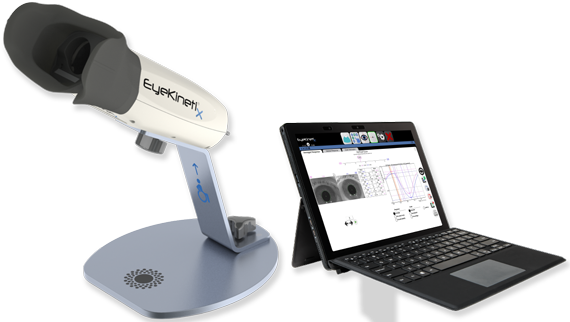EyeKinetix® Pupillography by Konan Medical
Making it easy to objectively assess
and measure the pupillary response.


EyeKinetix Pupillography by Konan Medical
Checking for pupillary dysfunction is a critical part of a comprehensive eye exam. In fact, the American Academy of Ophthalmology (AAO) and American Optometric Association (AOA) require that exams check for afferent pupillary defects (APDs), which signal dysfunction in the ocular system linked to a number of potential conditions.
In the past, this testing was done manually using the “swinging flashlight.” However, this method is subjective, it’s almost impossible to notice changes over time…and it’s especially difficult to assess pupil response when the iris is very dark. EyeKinetix, from Konan Medical, takes the guesswork out of detecting APDs and charts the pupillary response in a way that’s VERY easy for doctors to interpret.
This is cutting-edge technology that modernizes an important part of every exam by helping you improve the way you detect early signs of glaucoma, AMD, and a range of dysfunctions of the optic nerve. Asymmetric pupil response in particular is hard to detect, and the consequences for missing it can be very serious.
Add in the fact that the EyeKinetix is eligible for a 50% discount through the ADA Tax Credit and this device is an instant win for you and your patients!
How EyeKinetix Works
Like the swinging flashlight method, EyeKinetix uses light-based stimuli to measure and chart the pupillary response. This method, called “pupillography” utilizes high-definition cameras for precise measurement, simultaneously recording both direct and consensual pupillary light reflexes. Since it uses infrared light, results are precise even with very dark irises!
And, unlike the swinging flashlight method, EyeKinetix enables you to use OBJECTIVE data to identify APDs, which can indicate conditions like:
- Glaucoma
- Amblyopia
- Optic neuritis/MS
- Optic nerve tumor
- Optic nerve infections or inflammation
- Third cranial nerve palsies
- Retinal detachment
- Intraocular tumor
- Severe macular degeneration
- Retinal infection
- Alzheimer’s
- Autism
- Brain tumors
- Parkinson’s disease
- Traumatic optic neuropathy
Improving Your Diagnostic Capabilities
When you adopt EyeKinetix into your practice, you will see the following benefits:
Detect Eye Conditions Faster
With EyeKinetix, you can quickly (both eyes tested in 38 seconds) reveal even the smallest APDs caused by potentially life-threatening disorders. The real-time algorithm generates and graphs a precise measurement of pupillary response so that you can detect problems earlier than ever.


Quantify a Patient’s Eye Health
Past methods involved manual operation and subjective measurement — not the best formula for patient outcomes. With EyeKinetix, you get a full analysis in an objective, quantifiable way. Unlike human observers that only see one pupil reflex at a time, the EyeKinetix system simultaneously records both direct and consensual pupillary light reflexes.
Detailed, Easy-to-Interpret Reports
EyeKinetix features the RAPDx®, an automated test to assess relative APDs in less than one minute. RAPDx puts results from direct and consensual pupillary reflex into one easy-to-read number that tells you which eye sees more light as a result of pupillary asymmetry and the degree to which the APD is present.

Isn’t it time to say goodbye to the swinging flashlight test and upgrade the way you assess and measure pupils in your practice? Contact me by calling (407) 934-0534 or setting up a time to talk using my personal calendar!

